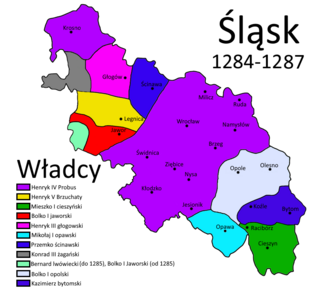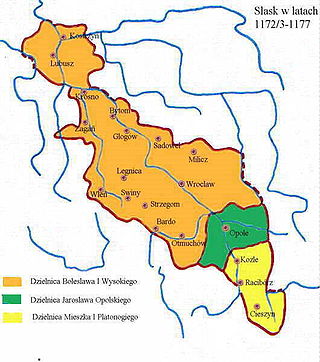The Duke of Silesia was the title of sons and descendants of the Polish Duke Bolesław III Wrymouth. In accordance with the last will and testament of Bolesław, upon his death his lands were divided into four or five hereditary provinces distributed among his sons, and a royal province of Kraków reserved for the eldest, who was to be High Duke of all Poland. This was known as the fragmentation of Poland. Subsequent developments lead to further splintering of the duchies.

The Duchy of Silesia with its capital at Wrocław was a medieval duchy located in the historic Silesian region of Poland. Soon after it was formed under the Piast dynasty in 1138, it fragmented into various Silesian duchies. In 1327, the remaining Duchy of Wrocław as well as most other duchies ruled by the Silesian Piasts passed to the Kingdom of Bohemia as Duchies of Silesia. The acquisition was completed when King Casimir III the Great of Poland renounced his rights to Silesia in the 1335 Treaty of Trentschin.

The Duchies of Silesia were the more than twenty divisions of the region of Silesia formed between the 12th and 14th centuries by the breakup of the Duchy of Silesia, then part of the Kingdom of Poland. In 1335, the duchies were ceded to the Kingdom of Bohemia under the Treaty of Trentschin. Thereafter until 1742, Silesia was one of the Bohemian crown lands and lay within the Holy Roman Empire. Most of Silesia was annexed by the King of Prussia under the Treaty of Berlin in 1742. Only the Duchy of Teschen, the Duchy of Troppau and the Duchy of Nysa remained under the control of the Bohemian crown and as such were known as the Duchy of Upper and Lower Silesia until 1918.

The Duchy of Bytom was a duchy in Upper Silesia, one of the Silesian duchies of fragmented Piast-ruled Poland. It was established in Upper Silesia about 1281 during the division of the Duchy of Opole and Racibórz among the sons of Duke Władysław Opolski. The duchy's capital was Bytom, formerly part of Lesser Poland until in 1177 the Polish High Duke Casimir II the Just had attached it to the Silesian Duchy of Racibórz.

The Silesian Piasts were the elder of four lines of the Polish Piast dynasty beginning with Władysław II the Exile (1105–1159), eldest son of Duke Bolesław III of Poland. By Bolesław's testament, Władysław was granted Silesia as his hereditary province and also the Lesser Polish Seniorate Province at Kraków according to the principle of agnatic seniority.

Wenceslaus I of Cieszyn, was a Duke of Cieszyn from 1431, Duke of half of Bytom during 1431–1452 and Duke of Siewierz.
Przemyslaus II of Cieszyn, also known as Primislaus II of Teschen or Przemko II, was a Duke of Cieszyn from 1431, ruler over Bielsko and Skoczów, Duke of half of both Duchy of Głogów and Duchy of Ścinawa from 1460 and from 1468 sole ruler over Cieszyn.

Bolesław II of Cieszyn , was a Duke of Cieszyn since 1431, ruler over half of Bielsko and Frysztat, and during 1452 sole ruler over one half of Bytom.

Duchy of Racibórz was one of the duchies of Silesia, formed during the medieval fragmentation of Poland into provincial duchies. Its capital was Racibórz in Upper Silesia.
Przemko II of Głogów was a Duke of Żagań, Ścinawa, etc., from 1309 to 1321, Duke of Oleśnica, Namysłów, Gniezno and Kalisz from 1309 to 1312 and Duke of Głogów starting in 1318.

Konrad I of Oleśnica was a Duke of Żagań and Ścinawa during 1309–1312, Duke of Oleśnica, Namysłów, Gniezno and Kalisz during 1312–1313, Duke of Kalisz during 1313–1314 (alone), Duke of Namysłów from 1313 (alone) and Duke of Oleśnica from 1321 until his death (alone).

Konrad II the Gray was a Duke of Oleśnica, Koźle and half of Bytom since 1366 and Duke of half of Ścinawa since 1397 until his death.
Casimir of Bytom was a Duke of Opole during 1282–1284 and Duke of Bytom from 1284 until his death.
Bolko I of Opole, was a Duke of Opole from 1282, Niemodlin and Strzelce Opolskie until his death.
Władysław of Bytom, was a Duke of Koźle during 1303-1334, Duke of Bytom from 1316, Duke of Toszek from 1329 and Duke of Siewierz during 1328–1337.
Siemowit of Bytom (Polish: Siemowit bytomski;, was a Duke of Bytom during 1312–1316 and Duke of Gliwice from 1340 until his death.

Wenceslaus of Niemodlin was Duke of Niemodlin from 1365 until his death, and Duke of Gliwice from 1364.

Bolko II of Opole was a Duke of Opole from 1313.
Leszek of Racibórz was a Duke of Racibórz since 1306 and Duke of Koźle from 1334 until his death.

Jan II of Opole was a Duke of Opole-Brzeg -Strzelce-Niemodlin in 1476, ruler over Gliwice, Toszek, Niemodlin, Bytom, Koźle, and Racibórz. He belonged to the Silesian branch of the Polish Piast dynasty which was the oldest branch of the first Polish royal dynasty.








